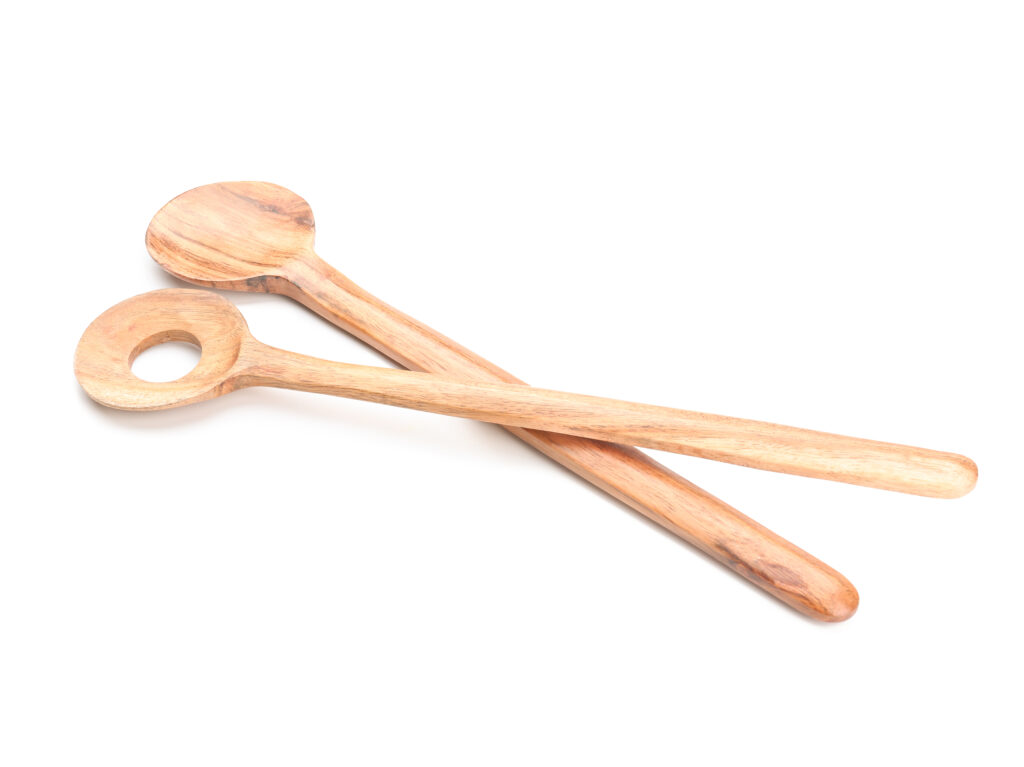Wooden spoons come in all shapes and sizes, and are used for anything from baking, cooking or mixing dishes and cakes.
Here Is Why Wooden Spoons Have A Hole In The Middle:
Wooden spoons have a hole in the middle because it prevents the spoon from rotting and splitting (in the middle), it makes the spoon easier to clean, great for scraping pans and easier to stir dishes.
We will go into further detail on why wooden spoons have a hole in the middle and the benefits of using wood over plastic. I am sure this will answer your questions regarding holes and wooden spoons.

Why Do Wooden Spoons Have A Hole In The Middle?
Wooden spoons tend to have a hole in the middle. Here are some reasons why:
1. Prevents It From Rotting and Splitting
The hole in the middle of a wooden spoon helps prevent it from rotting and splitting because the end grain of the wood (its growth rings) is more vulnerable to moisture than its side grain, so having the hole in the middle allows any moisture to drain out.
2. Easy To Clean
The hole also makes the spoon easier to clean, as it allows you to get inside of whatever pot or pan that you are using. This reduces the amount of effort needed to scrub off any baked-on food.
3. If You Need To Scrape Something Off The Bottom Of A Pan
If you need to scrape something off the bottom of a pan, having the hole in the middle makes it easier. The best tool for this job is usually a spoon with a contoured head, rather than one with an angled or flathead. Since most spoons are made out of wood, they can be hard to shape into this contoured head without the hole in the middle.
4. For Stirring With One Hand While Holding Your Pan/Pot With The Other
Having the hole in the middle also makes it easier to stir with one hand while holding your pan or pot with the other. This is because you can rest some of the weight of the spoon on the lip of your pan/pot while still being able to use a firm grip.
What Is The Hole In The Spoon For?
The hole in the spoon is for a number of reasons.
It helps prevent it from rotting and splitting, makes it easier to clean, allows you to scrape things off the bottom of pans or pots with ease, and also for stirring with one hand while holding your pan/pot with the other.
What Are The Benefits Of Wood Over Plastic For A Spoon With A Hole In The Middle?
Wooden spoons have many advantages over plastic.
i. Wooden Spoons Are More Versatile
A wooden spoon can be used for a variety of foods and cooking methods, such as meat, eggs, soups, vegetables, etc. A plastic spoon is generally only useful for liquids. It also does not scratch or damage cookware like metal utensils/spoons might do.
ii. Wooden Spoons Are Easier To Clean
Wooden spoons are easier to clean because the hole in the middle makes it easy for water and soap to flow through. Plastic utensils, on the other hand, might need to be manually scrubbed with a dishrag or sponge.
iii. Wooden Spoons Look Classier Than Plastic Utensils
Plastic utensils tend to look cheaper than wooden ones. Wood looks more elegant and it is often less expensive per unit but provides the same functionality as plastic, if not better. They are also more durable in the sense that they do not break easily.
iv. Wooden Spoons Are Eco Friendly
Plastic utensils are usually manufactured from petroleum. Petroleum is a non-renewable resource that has caused wide-scale damage to the environment in several ways, especially when it leaks into water tables and nearby wildlife habitats.
Plastic utensils are also not biodegradable because they are too complex in their molecular structure for microbes to break down.
Wooden spoons are made from renewable resources, such as plant matter rather than petroleum, which is a non-renewable resource that has caused wide-scale damage to the environment in several way
s. Wooden utensils are also biodegradable because they are naturally occurring polymers consisting of carbon, hydrogen, oxygen, and sometimes sulfur.
v. Wooden Spoons Are Stronger Than Plastic Utensils
Wooden spoons are much harder than plastic ones, even if they are both made out of the same wood. Wood is a natural composite material containing cellulose fibres that are tightly bonded with lignin to form rigid cell walls within each plant’s secondary tissues. This makes it more durable and strong than plastic.
Wooden spoons have been around for centuries, and they are still used today because of their durability. The hole in the middle helps with a variety of tasks such as preventing rotting, making it easier to clean–both by hand or dishwasher–and also by allowing you to use one hand while stirring food on the stovetop.
Wooden utensils will last much longer than plastic ones which tend to break after just a few uses. They’re also environmentally friendly because they can be composted if need be! Here is a great article on how wooden spoons are better than plastic.

